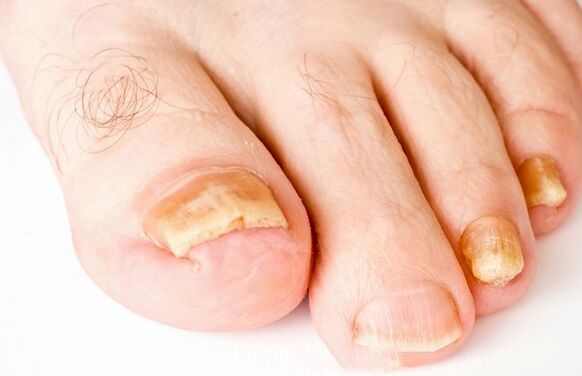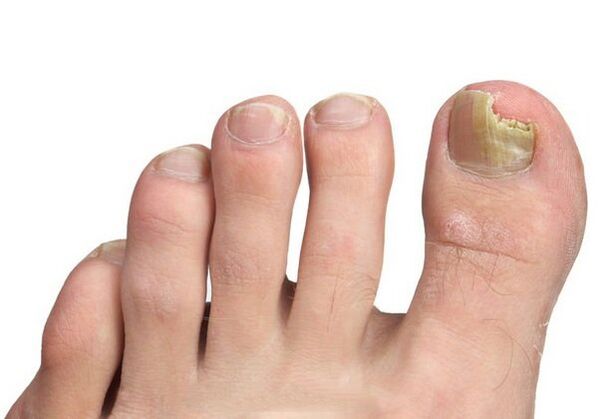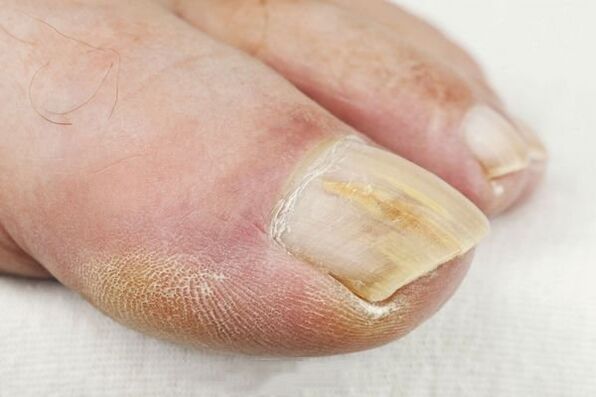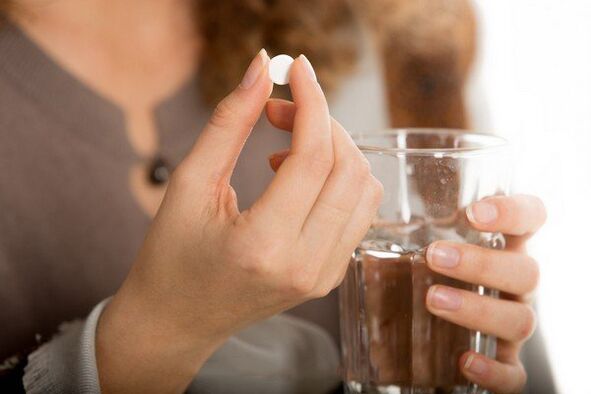Hello, dear readers.Onychomycosis is a medical name for a very common disease, better known to us as a nail fungus.Recently, a leap was observed at the level of incidence of this disease.This unpleasant fact is associated with the popularity of cheap shoes, which is not particularly quality.It is made of low degree materials with low air transfer rate, which prevents normal foot ventilation.Under such conditions, with the perspiration of the feet, ideal conditions are created for the productive activity of pathogenic microflora.This problem is widespread.Its scope is so large that the number of cases exceeds 20% of all inhabitants on the planet!
As the name implies, nail fungus is a mycotic (fungal) damage on the nail plate.There are many varieties of pathogenic fungi that can cause this disease.
But according to doctors, in most cases, nail plates in the legs are affected by dermatophytes.Significantly less often, the cause of disease development is yeast (candidiasis) and mold fungi.
Sometimes, in practice, you need to deal with nail deformation in black legs.
Nail fungus symptoms - the first signs
Fungal damage can affect not only nails but also the feet.Symptoms in infection will differ depending on the pathogen variety that caused the development of the disease.The degree of damage to the nail plate also has a value.
But despite existing differences, the general signs of fungal activity can be distinguished:
- Changing the color of the nail.
- The appearance of stains on the nail plate, stripes, thickening, influoxes.
- Loosening the structure of nails or stratification.
- Redness, peeling, cracks from the skin of the feet.
- The appearance of itching, pain (even when walking), burning in the area of damage.
- Inflammation, dryness of affected areas of the skin.
- Often the feet exude a repulsive aroma.
A whitish plate can be observed at the bottom of the feet.Skin peeling is replaced by the appearance of small skinflins that cover its surface.
Types of fungal lesions
Normotrophic shape of damage.White or yellowish stains or strips appear on the nails.As the disease advances, they spread, gradually changing the color of the entire plate.
The thickness, as well as the shine of its surface, remains unchanged.There may be a violation of nail fusion with submarine tissues, which is why it exfoliates and can be removed easily and pain.

Hypertrophic form of the disease.The affected nail becomes ranked yellow or gray.A nail plate thickening is observed due to the growth of the undermarine epithelium.The nail plaque itself becomes a crumb.
The side parts are especially destroyed, because of this, it acquires a form of claw.This is a characteristic sign of this disease.The surface of the nail becomes monotonous.When walking, a sick person experiences pain.
Atrophic form of damage. The nail plate changes color, becoming brown gray, loses its transparency and shine.The nail begins to collapse gradually, from the outside towards the nail growth zone.
The growth epithelial particles fill the nail bed with loose mass.Without treatment, there will be a complete loss of nails.
Disease Pathogen Classification
Dermatophytic lesion.It occurs in the vast majority of cases (about 90%).There are several varieties.With some, the infection can apply to interspersed areas on the foot, the skin of the legs and even the hands.
Defeat of yeast.This variety can be difficult to identify, especially in the early stages.The nail roll is first affected, inflate and swell.Later, peeling in this area is noticeable, lightweight itching and weak pain may be possible.The nail becomes tuberous, loses its shine, can crumble.In advanced cases, purulent discharge appears.
Defeat with plains.Under the influence of the mold, the nails change, acquiring a greenish and bluish tone or begins to darken.
Its side parts become difficult.Over time, the affected areas die, which is why the nail is deformed.Gradually, it will collapse.
Flat defeat is quite rare, especially as a complication in a different way of fungal lesions as well as with HIV infection.
Classification by the location of the injury
Fungi damage can be located in different parts of the nail.In this sense, various types of damage are distinguished in the international classification.
- Total when the effect of the fungus covers the entire nail.
- Far, if only the top of the nail (free edge) is injured.
- Proximal, in which there is damage to the nail roll (bottom of the nail plate).
- Lateral, observed in the sides of the nails.
Often they characterize different stages of the disease.
The fungus injury of the feet
There are several varieties of fungal damage to the foot.
Interdalz form. The most common type of foot fungus.As the name can be seen, the disease affects interdigital gaps, later it can also change to other parts of the feet, including nails.
In interdigital folds, moist cracks and specific skin layers appear for the first time.Later, skin erosion is noticeable.The disease has a tendency to become a chronicle.Often complicated by streptococcal infection
Hyperteericatic form (squamous).Touches the whole foot.It differs in a very deep defeat of tissues.At first the skin retreats and lightly blushes, so it gets rough and anxious, in the heels, sometimes there is a deep crack of the keratinized layer.
The disease can spread to the nails, which at the same time thickens, darkens and begins to paint.The disease is very characteristic of athletes.
Dishydrotic (vesicular) form. The vesicle (bubbles with liquid) appears on the feet, which, after breaking, leaves traces of erosion.The skin is ulcerated, with peeling areas, covered with purulent crusts.It is often accompanied by an allergic rash (due to the action of toxins).
The disease is uncommon and treated quite easily.But here the danger is in the high probability of bacteria or virus injuries, which significantly complicates the course of the disease and really excludes the possibility of rapid recovery.
Shaped faded.It is not easy to identify, as changes in the skin and the condition of nails are weak.Nail plates can become yellowish.The skin on the sole is slightly peeled, is loose.Ia can be observed.The disease is well provided to the curve.
Nail Fungus - The Causes of Appearance
Nail fungus symptoms and the first signs that signal the general level of immune body resistance and inadequate feet care.

If protection functions are normal, even when infected, the disease will not be able to develop.Immunological mechanisms will deal with the perpetrator on their own.
But when immunity is weakened in conjunction with related causes favorable to the development of the disease, the body will not be able to resist the fungus.
For an effective struggle with this, you need to try to eliminate or at least minimize (for example, it is unlikely that chronic diseases will be completely overcome) the influence of these factors.
The reasons for the development of the fungus:
- Excessive leg perspiration.
- Violation of natural feet ventilation (dense shoes made of low quality material, synthetic socks).
- Reducing body protection functions.
- Violation of the protective layer of the skin (excess hygiene, excessive treatment with antibacterial agents, fluid abuse to relieve varnish).
- Nail plate injury and leg damage (cracks, corns, etc.).
- Features of the foot that worsen their aeration (due to boring feet, obesity, etc.).
- Concomitant diseases (diabetes, varicose veins, psoriasis, metabolic disorders, digestion, blood circulation in the legs, HIV).
- Antibiotics and some other medicines taken by a long course.
- Low level of feet hygiene.
- Age and sexual criteria (men and the elderly are more susceptible to disease).
- A professional factor (conditions with high temperature and humidity, dust, ionizing radiation, wearing rubber shoes; masseurs, orthopedists, sanatorium workers, vapors, etc.) are also sick.
- A visit to public saunas, baths, swimming pools.
- Pedra of the hall in violation of the principles of hygiene and sterility.
- Domestic factor (general use of cloths, slippers, bathroom rug, etc.).
As studies have shown, people suffering from diabetes are more affected by the fungus of the foot and nails.This disease is observed in 35% of diabetics.
The probability of causing fungal damage to psoriasis is also high.Here, the probability of increasing by 55%.
The consequences of fungal lesions

Although foot fungus does not represent a direct threat to the patient's life, you cannot relate to your irresponsible health and let everything go for yourself.
Fungal damage is not an irritating discomfort and an exceptionally aesthetic problem.
The timely inconsistency of the disease leads to the development in a chronic way of diseases with regular exacerbations.
Amazing complications are also possible.
- Violation of nail growth process, growing in soft tissues.
- Complete or partial loss of nail.
- Stagnated phenomena, including lympostase.
- Distribution of the disease to neighboring areas and deeply in tissues.
- Connecting other infections (bacterial, viral and fungal).
- High inflammation is an acute inflammatory infectious disease.
- The diabetic foot in diabetics is anatomical changes, leading to an increase in the likelihood of injury, infection, suppression and necrosis (necrosis) of the tissues.
- Elefantiasis is a pathological growth of the skin and subcutaneous tissues, leading to an increase in organ size.
- Eczema.
Treatment of nail fungus - cheap and effective medicines
To prescribe the correct treatment regime, you need to make a precise diagnosis.For this purpose, various laboratory tests are performed.Modern pharmacology offers many different antifungal medications.
This is why independent treatment is difficult and often ends up being ineffective.The doctor will have to discover the pathogen, the degree of neglect of the disease, the area of damage, the presence of concomitant diseases.
Only based on the information complex received, can it prescribe a therapy course.Here, both local medications are used (for outer application - ointments, creams, varnishes, foams, serums) and general, taken inside (tablets, capsules).
The active substance in antifungal ointments can be cyclopirox, naphtifine, nystatin.
If the fungus lesions are quite extensive, the use of antimycotic drugs for tablets is recommended.
Unlike external funds, tablets have a general effect throughout the patient's body.
Purely prescribed medications based on terbinafine, fluconazole, itraconazole substances.Often, surgical removal of formations is required, but there are cheap and effective drugs from nail fungus.

Many of these funds are also indicated for preventive use.
It should be remembered that all antimycotic medications have a different side effect.Therefore, treatment, prescription and cancellation of medicines, control of the patient's condition - all this is exclusively in the competence of the doctor.
Often the recovery process can be very prolonged, up to one year, until the affected nail is completely updated.
During the treatment period, special attention should be given to leg hygiene.With damage caused by fungal nails, the use of decorative varnishes is not allowed.
To avoid families infection, you cannot walk barefoot at home, using only closed shoes.It needs to be treated twice a day with antifungal agents.After using the bath, your careful processing is performed.
The joint washing of things is prohibited.After healing, you need to get rid of all objects that have come into contact with the feet (cloths, slippers, all socks, etc.).
Recommendations
- The legs should be kept clean and dry.Wash your feet once a day if necessary - more often.After that, its surface, including interdigital gaps, diligently dries.Now you only need to wear fresh socks.
- Shoes should be comfortable, not too old (no more than 3 years), of breathable material.Poor or fashion rubber models cannot be used daily.At least, the duration of use during the day should be limited.For this purpose, it is recommended to use a replaceable pair.It is extremely recommended to wear other people's shoes, including slippers.
- Socks are used from cotton, wool or other non -intensive materials.It is allowed to use synthetic only in some cases.
- The hardest thing is to destroy the fungus on wooden surfaces.This should be taken into consideration when visiting public vapors, baths, pools.It is better to be in a closed rubber shoe.
- Socks, room shoes, insoles need to be organized regularly.
- The salon pedicure procedure must be performed by a proven master, subject to rules of sterility.Or at home adhering to the same principles.It is necessary to avoid all types of nail plates lesions in every way possible, to timely eliminate the characteristic problems of the surface of the sole (insensitive, callus, cracks), not abuse pedicure, degreasing and disinfectant.
Take care, follow your health.Be healthy!
















